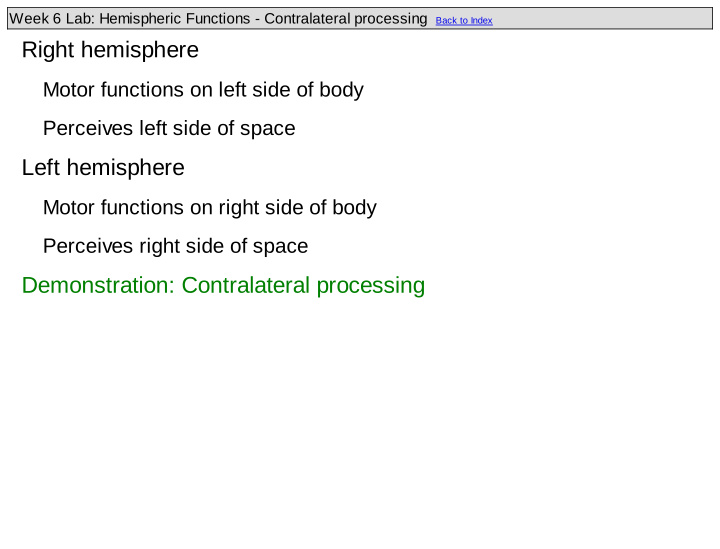



Week 6 Lab: Hemispheric Functions - Contralateral processing Back to Index Right hemisphere Motor functions on left side of body Perceives left side of space Left hemisphere Motor functions on right side of body Perceives right side of space Demonstration: Contralateral processing
Week 6 Lab: Hemispheric Functions - Split Brain Patients Back to Index Corpus Collosum connects two hemispheres Split brain patients have Corpus Collosum cut to reduce seizures Hemispheres cannot communicate Each hemisphere can be tested separately Link: Split brain patient
Week 6 Lab: Hemispheric Functions - Determining hemispheric Functions Back to Index WADA test Inject anesthetic (sodium amytol) into the right or left internal carotid artery Puts one hemisphere to sleep so we can see what functions are there
Week 6 Lab: Hemispheric Functions - Pain in the Brain Back to Index Left Right Hemisphere Hemisphere Damage Damage Catastrophic 62% 10% Indifferent 11% 38% Emotional reactions to unilateral brain damage Catastrophic: dysphoric reaction - despair, hopelessness or anger Indifferent: euphoric reaction - minimization of symptoms, placidity or elation.
Week 6 Lab: Hemispheric Functions - Language Centers and Handedness Back to Index Left Hemisphere Right Hemisphere Most language, including grammar Face recognition Understanding verbal material Attention Verbal Memory Non-Verbal Memory Understanding Space Hemispheric dominance as revealed by neurological patients
Week 6 Lab: Hemispheric Functions - Brain Words Back to Index WADA test Inject anesthetic (sodium amytol) into the right or left internal carotid artery Left Right Hemisphere Hemisphere Bilateral Dominant Dominant Right Handed 95% 5% 0% Left Handed 70% 15% 15% Language representation as revealed by sodium (from Ramussen and Milner 1977)
Week 6 Lab: Hemispheric Functions - Gender Back to Index Men Women Corpus callosum Relatively smaller Relatively larger Aphasia after left 3 times more likely 3 times less likely hemisphere damage than women than men Ventricles stay the Schizophrenia Ventricles get larger same Right amygdala active Left amygdala active Amygdala with rest of brain with rest of brain Brain Size Relatively Larger Relatively Smaller Hemispheric Differences Between Men and Women
Week 6 Lab: Effects of Brain Damage - Hemispatial neglect Back to Index Definition: A failure to report, respond or orient to stimuli presented contralateral to the side of a brain lesion in the absence of elementary motor or sensory deficits. Incidence of neglect 86% right hemisphere damage 7% left hemisphere damage 7% bilateral damage Link: Hemispatial Neglect: 0 to 3:18 of video
Week 6 Lab: Effects of Brain Damage - Awareness impariments Back to Index Anosognosia - lack of awareness or denial of any problem Link: Anosognosia: 5:45 to 9:00 Anosodiaphoria - awareness of deficit but without appropriate concern.
Week 6 Lab: Effects of Brain Damage - Alien hand syndrome Back to Index Inability to control one hand Hand can perform complex motor behaviors (like buttoning a shirt) Link: Alien Hand Syndrome Patient
Week 6 Lab: Effects of Brain Damage - Phantom limbs - Definition and Causes Back to Index Experience sensation of limb that is missing Telescoping Decrease in length of perceived limb until it reaches body More common in upper limb amputees than lower limb amputees Up to 80% feel phantom pain Patients Amputees Spinal chord injuries Congenital limb absence
Week 6 Lab: Effects of Brain Damage - Phantom limbs - Treatment for Cramping Back to Index Phantom limbs are 'stuck' and cramped with pain No visual feedback that limb is moving Treatment: Mirror therapy Existing arm in one slot Mirror image is superimposed where phantom arm would be Move real arm until matches position of phantom limb Close their eyes and make symmetric movements then open eyes 6/10 subjects perceived phantom limb as moving 4/5 subjects with involuntary clenching spasms found relief Temperature did not transfer (control for confabulation) Link: Mirror Therapy
Week 6 Lab: Effects of Brain Damage - Cortical Reorganization Back to Index Patient loses thumb, then some time later feels thumb when cheek is scratched Somatosensory Map of Cortex Explanation of Cortical Reorganization Thumb area is near face area Thumb receives no input, face area expands into face area
Recommend
More recommend